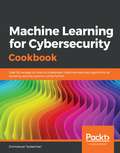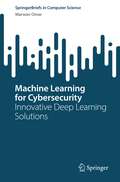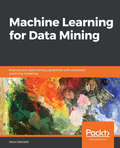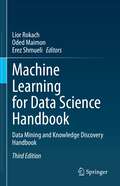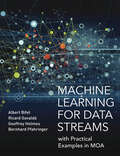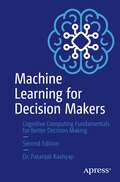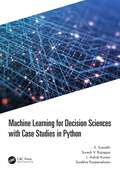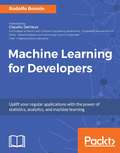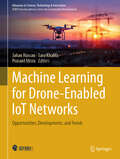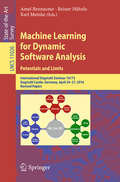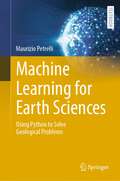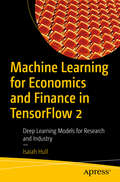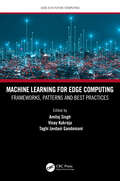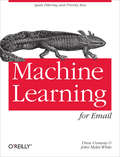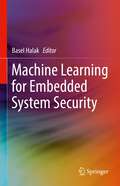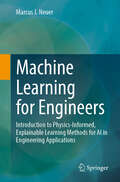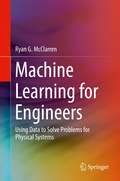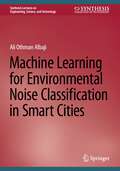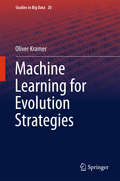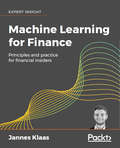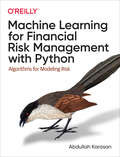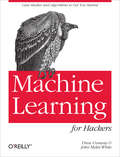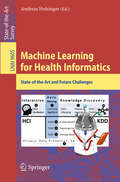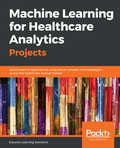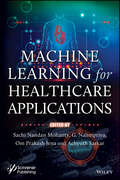- Table View
- List View
Machine Learning for Cybersecurity Cookbook: Over 80 recipes on how to implement machine learning algorithms for building security systems using Python
by Emmanuel TsukermanLearn how to apply modern AI to create powerful cybersecurity solutions for malware, pentesting, social engineering, data privacy, and intrusion detection Key Features Manage data of varying complexity to protect your system using the Python ecosystem Apply ML to pentesting, malware, data privacy, intrusion detection system(IDS) and social engineering Automate your daily workflow by addressing various security challenges using the recipes covered in the book Book Description Organizations today face a major threat in terms of cybersecurity, from malicious URLs to credential reuse, and having robust security systems can make all the difference. With this book, you'll learn how to use Python libraries such as TensorFlow and scikit-learn to implement the latest artificial intelligence (AI) techniques and handle challenges faced by cybersecurity researchers. You'll begin by exploring various machine learning (ML) techniques and tips for setting up a secure lab environment. Next, you'll implement key ML algorithms such as clustering, gradient boosting, random forest, and XGBoost. The book will guide you through constructing classifiers and features for malware, which you'll train and test on real samples. As you progress, you'll build self-learning, reliant systems to handle cybersecurity tasks such as identifying malicious URLs, spam email detection, intrusion detection, network protection, and tracking user and process behavior. Later, you'll apply generative adversarial networks (GANs) and autoencoders to advanced security tasks. Finally, you'll delve into secure and private AI to protect the privacy rights of consumers using your ML models. By the end of this book, you'll have the skills you need to tackle real-world problems faced in the cybersecurity domain using a recipe-based approach. What you will learn Learn how to build malware classifiers to detect suspicious activities Apply ML to generate custom malware to pentest your security Use ML algorithms with complex datasets to implement cybersecurity concepts Create neural networks to identify fake videos and images Secure your organization from one of the most popular threats – insider threats Defend against zero-day threats by constructing an anomaly detection system Detect web vulnerabilities effectively by combining Metasploit and ML Understand how to train a model without exposing the training data Who this book is for This book is for cybersecurity professionals and security researchers who are looking to implement the latest machine learning techniques to boost computer security, and gain insights into securing an organization using red and blue team ML. This recipe-based book will also be useful for data scientists and machine learning developers who want to experiment with smart techniques in the cybersecurity domain. Working knowledge of Python programming and familiarity with cybersecurity fundamentals will help you get the most out of this book.
Machine Learning for Cybersecurity: Innovative Deep Learning Solutions (SpringerBriefs in Computer Science)
by Marwan OmarThis SpringerBrief presents the underlying principles of machine learning and how to deploy various deep learning tools and techniques to tackle and solve certain challenges facing the cybersecurity industry.By implementing innovative deep learning solutions, cybersecurity researchers, students and practitioners can analyze patterns and learn how to prevent cyber-attacks and respond to changing malware behavior. The knowledge and tools introduced in this brief can also assist cybersecurity teams to become more proactive in preventing threats and responding to active attacks in real time. It can reduce the amount of time spent on routine tasks and enable organizations to use their resources more strategically. In short, the knowledge and techniques provided in this brief can help make cybersecurity simpler, more proactive, less expensive and far more effectiveAdvanced-level students in computer science studying machine learning with a cybersecurity focus will find this SpringerBrief useful as a study guide. Researchers and cybersecurity professionals focusing on the application of machine learning tools and techniques to the cybersecurity domain will also want to purchase this SpringerBrief.
Machine Learning for Data Mining: Improve your data mining capabilities with advanced predictive modeling
by Jesus SalcedoGet efficient in performing data mining and machine learning using IBM SPSS Modeler Key FeaturesLearn how to apply machine learning techniques in the field of data scienceUnderstand when to use different data mining techniques, how to set up different analyses, and how to interpret the resultsA step-by-step approach to improving model development and performanceBook DescriptionMachine learning (ML) combined with data mining can give you amazing results in your data mining work by empowering you with several ways to look at data. This book will help you improve your data mining techniques by using smart modeling techniques.This book will teach you how to implement ML algorithms and techniques in your data mining work. It will enable you to pair the best algorithms with the right tools and processes. You will learn how to identify patterns and make predictions with minimal human intervention. You will build different types of ML models, such as the neural network, the Support Vector Machines (SVMs), and the Decision tree. You will see how all of these models works and what kind of data in the dataset they are suited for. You will learn how to combine the results of different models in order to improve accuracy. Topics such as removing noise and handling errors will give you an added edge in model building and optimization.By the end of this book, you will be able to build predictive models and extract information of interest from the datasetWhat you will learnHone your model-building skills and create the most accurate modelsUnderstand how predictive machine learning models workPrepare your data to acquire the best possible resultsCombine models in order to suit the requirements of different types of dataAnalyze single and multiple models and understand their combined resultsDerive worthwhile insights from your data using histograms and graphsWho this book is forIf you are a data scientist, data analyst, and data mining professional and are keen to achieve a 30% higher salary by adding machine learning to your skillset, then this is the ideal book for you. You will learn to apply machine learning techniques to various data mining challenges. No prior knowledge of machine learning is assumed.
Machine Learning for Data Science Handbook: Data Mining and Knowledge Discovery Handbook
by Lior Rokach Oded Maimon Erez ShmueliThis book organizes key concepts, theories, standards, methodologies, trends, challenges and applications of data mining and knowledge discovery in databases. It first surveys, then provides comprehensive yet concise algorithmic descriptions of methods, including classic methods plus the extensions and novel methods developed recently. It also gives in-depth descriptions of data mining applications in various interdisciplinary industries.
Machine Learning for Data Streams: With Practical Examples in MOA (Adaptive Computation and Machine Learning Series)
by Bernhard Pfahringer Albert Bifet Ricard Gavalda Geoff HolmesA hands-on approach to tasks and techniques in data stream mining and real-time analytics, with examples in MOA, a popular freely available open-source software framework. Today many information sources—including sensor networks, financial markets, social networks, and healthcare monitoring—are so-called data streams, arriving sequentially and at high speed. Analysis must take place in real time, with partial data and without the capacity to store the entire data set. This book presents algorithms and techniques used in data stream mining and real-time analytics. Taking a hands-on approach, the book demonstrates the techniques using MOA (Massive Online Analysis), a popular, freely available open-source software framework, allowing readers to try out the techniques after reading the explanations. The book first offers a brief introduction to the topic, covering big data mining, basic methodologies for mining data streams, and a simple example of MOA. More detailed discussions follow, with chapters on sketching techniques, change, classification, ensemble methods, regression, clustering, and frequent pattern mining. Most of these chapters include exercises, an MOA-based lab session, or both. Finally, the book discusses the MOA software, covering the MOA graphical user interface, the command line, use of its API, and the development of new methods within MOA. The book will be an essential reference for readers who want to use data stream mining as a tool, researchers in innovation or data stream mining, and programmers who want to create new algorithms for MOA.
Machine Learning for Decision Makers: Cognitive Computing Fundamentals for Better Decision Making
by Patanjali KashyapThis new and updated edition takes you through the details of machine learning to give you an understanding of cognitive computing, IoT, big data, AI, quantum computing, and more. The book explains how machine learning techniques are used to solve fundamental and complex societal and industry problems.This second edition builds upon the foundation of the first book, revises all of the chapters, and updates the research, case studies, and practical examples to bring the book up to date with changes that have occurred in machine learning. A new chapter on quantum computers and machine learning is included to prepare you for future challenges. Insights for decision makers will help you understand machine learning and associated technologies and make efficient, reliable, smart, and efficient business decisions. All aspects of machine learning are covered, ranging from algorithms to industry applications. Wherever possible, required practical guidelines and best practices related to machine learning and associated technologies are discussed. Also covered in this edition are hot-button topics such as ChatGPT, superposition, quantum machine learning, and reinforcement learning from human feedback (RLHF) technology. Upon completing this book, you will understand machine learning, IoT, and cognitive computing and be prepared to cope with future challenges related to machine learning.What You Will LearnMaster the essentials of machine learning, AI, cloud, and the cognitive computing technology stackUnderstand business and enterprise decision-making using machine learningBecome familiar with machine learning best practicesGain knowledge of quantum computing and quantum machine learningWho This Book Is ForManagers tasked with making key decisions who want to learn how and when machine learning and related technologies can help them
Machine Learning for Decision Sciences with Case Studies in Python
by S. Sumathi Suresh Rajappa L Ashok Kumar Surekha PaneerselvamThis book provides a detailed description of machine learning algorithms in data analytics, data science life cycle, Python for machine learning, linear regression, logistic regression, and so forth. It addresses the concepts of machine learning in a practical sense providing complete code and implementation for real-world examples in electrical, oil and gas, e-commerce, and hi-tech industries. The focus is on Python programming for machine learning and patterns involved in decision science for handling data. Features: Explains the basic concepts of Python and its role in machine learning. Provides comprehensive coverage of feature engineering including real-time case studies. Perceives the structural patterns with reference to data science and statistics and analytics. Includes machine learning-based structured exercises. Appreciates different algorithmic concepts of machine learning including unsupervised, supervised, and reinforcement learning. This book is aimed at researchers, professionals, and graduate students in data science, machine learning, computer science, and electrical and computer engineering.
Machine Learning for Developers
by Rodolfo BonninYour one-stop guide to becoming a Machine Learning expert. <p> About This Book <p>• Learn to develop efficient and intelligent applications by leveraging the power of Machine Learning <p>• A highly practical guide explaining the concepts of problem solving in the easiest possible manner <p>• Implement Machine Learning in the most practical way <p><p> Who This Book Is For <p> This book will appeal to any developer who wants to know what Machine Learning is and is keen to use Machine Learning to make their day-to-day apps fast, high performing, and accurate. Any developer who wants to enter the field of Machine Learning can effectively use this book as an entry point. <p><p> What You Will Learn <p>• Learn the math and mechanics of Machine Learning via a developer-friendly approach <p>• Get to grips with widely used Machine Learning algorithms/techniques and how to use them to solve real problems <p>• Get a feel for advanced concepts, using popular programming frameworks. <p>• Prepare yourself and other developers for working in the new ubiquitous field of Machine Learning <p>• Get an overview of the most well known and powerful tools, to solve computing problems using Machine Learning. <p>• Get an intuitive and down-to-earth introduction to current Machine Learning areas, and apply these concepts on interesting and cutting-edge problems. <p><p> In Detail <p> Most of us have heard about the term Machine Learning, but surprisingly the question frequently asked by developers across the globe is, “How do I get started in Machine Learning?”. One reason could be attributed to the vastness of the subject area because people often get overwhelmed by the abstractness of ML and terms such as regression, supervised learning, probability density function, and so on. This book is a systematic guide teaching you how to implement various Machine Learning techniques and their day-to-day application and development. <p><p>You will start with the very basics of data and mathematical models in easy-to-follow language that you are familiar with; you will feel at home while implementing the examples. The book will introduce you to various libraries and frameworks used in the world of Machine Learning, and then, without wasting any time, you will get to the point and implement Regression, Clustering, classification, Neural networks, and more with fun examples. As you get to grips with the techniques, you'll learn to implement those concepts to solve real-world scenarios for ML applications such as image analysis, Natural Language processing, and anomaly detections of time series data. By the end of the book, you will have learned various ML techniques to develop more efficient and intelligent applications. <p><p> Style and approach <p> This book gives you a glimpse of Machine Learning Models and the application of models at scale using clustering, classification, regression and reinforcement learning with fun examples. Hands-on examples will be presented to understand the power of problem solving with Machine Learning and Advanced architectures, software installation, and configuration. <P><P><i>Advisory: Bookshare has learned that this book offers only partial accessibility. We have kept it in the collection because it is useful for some of our members. Benetech is actively working on projects to improve accessibility issues such as these.</i>
Machine Learning for Drone-Enabled IoT Networks: Opportunities, Developments, and Trends (Advances in Science, Technology & Innovation)
by Sara Khalifa Jahan Hassan Prasant MisraThis book aims to explore the latest developments, challenges, and opportunities in the application of machine learning techniques to enhance the performance and efficiency of IoT networks assisted by aerial unmanned vehicles (UAVs), commonly known as drones. The book aims to include cutting edge research and development on a number of areas within the topic including but not limited to: •Machine learning algorithms for drone-enabled IoT networks •Sensing and data collection with drones for IoT applications •Data analysis and processing for IoT networks assisted by drones •Energy-efficient and scalable solutions for drone-assisted IoT networks •Security and privacy issues in drone-enabled IoT networks •Emerging trends and future directions in ML for drone-assisted IoT networks.
Machine Learning for Dynamic Software Analysis: International Dagstuhl Seminar 16172, Dagstuhl Castle, Germany, April 24-27, 2016, Revised Papers (Lecture Notes in Computer Science #11026)
by Amel Bennaceur Reiner Hähnle Karl MeinkeMachine learning of software artefacts is an emerging area of interaction between the machine learning and software analysis communities. Increased productivity in software engineering relies on the creation of new adaptive, scalable tools that can analyse large and continuously changing software systems. These require new software analysis techniques based on machine learning, such as learning-based software testing, invariant generation or code synthesis. Machine learning is a powerful paradigm that provides novel approaches to automating the generation of models and other essential software artifacts. This volume originates from a Dagstuhl Seminar entitled "Machine Learning for Dynamic Software Analysis: Potentials and Limits” held in April 2016. The seminar focused on fostering a spirit of collaboration in order to share insights and to expand and strengthen the cross-fertilisation between the machine learning and software analysis communities. The book provides an overview of the machine learning techniques that can be used for software analysis and presents example applications of their use. Besides an introductory chapter, the book is structured into three parts: testing and learning, extension of automata learning, and integrative approaches.
Machine Learning for Earth Sciences: Using Python to Solve Geological Problems (Springer Textbooks in Earth Sciences, Geography and Environment)
by Maurizio PetrelliThis textbook introduces the reader to Machine Learning (ML) applications in Earth Sciences. In detail, it starts by describing the basics of machine learning and its potentials in Earth Sciences to solve geological problems. It describes the main Python tools devoted to ML, the typival workflow of ML applications in Earth Sciences, and proceeds with reporting how ML algorithms work. The book provides many examples of ML application to Earth Sciences problems in many fields, such as the clustering and dimensionality reduction in petro-volcanological studies, the clustering of multi-spectral data, well-log data facies classification, and machine learning regression in petrology. Also, the book introduces the basics of parallel computing and how to scale ML models in the cloud. The book is devoted to Earth Scientists, at any level, from students to academics and professionals.
Machine Learning for Economics and Finance in TensorFlow 2: Deep Learning Models for Research and Industry
by Isaiah HullWork on economic problems and solutions with tools from machine learning. ML has taken time to move into the space of academic economics. This is because empirical work in economics is concentrated on the identification of causal relationships in parsimonious statistical models; whereas machine learning is oriented towards prediction and is generally uninterested in either causality or parsimony. That leaves a gap for both students and professionals in the economics industry without a standard reference.This book focuses on economic problems with an empirical dimension, where machine learning methods may offer something of value. This includes coverage of a variety of discriminative deep learning models (DNNs, CNNs, RNNs, LSTMs, the Transformer Model, etc.), generative machine learning models, random forests, gradient boosting, clustering, and feature extraction. You'll also learn about the intersection of empirical methods in economics and machine learning, including regression analysis, text analysis, and dimensionality reduction methods, such as principal components analysis.TensorFlow offers a toolset that can be used to setup and solve any mathematical model, including those commonly used in economics. This book is structured to teach through a sequence of complete examples, each framed in terms of a specific economic problem of interest or topic. Otherwise complicated content is then distilled into accessible examples, so you can use TensorFlow to solve workhorse models in economics and finance.What You'll LearnDefine, train, and evaluate machine learning models in TensorFlow 2Apply fundamental concepts in machine learning, such as deep learning and natural language processing, to economic and financial problemsSolve workhorse models in economics and financeWho This Book Is ForStudents and data scientists working in the economics industry. Academic economists and social scientists who have an interest in machine learning are also likely to find this book useful.
Machine Learning for Edge Computing: Frameworks, Patterns and Best Practices (ISSN)
by Amitoj SinghThis book divides edge intelligence into AI for edge (intelligence-enabled edge computing) and AI on edge (artificial intelligence on edge). It focuses on providing optimal solutions to the key concerns in edge computing through effective AI technologies, and it discusses how to build AI models, i.e., model training and inference, on edge. This book provides insights into this new inter-disciplinary field of edge computing from a broader vision and perspective. The authors discuss machine learning algorithms for edge computing as well as the future needs and potential of the technology. The authors also explain the core concepts, frameworks, patterns, and research roadmap, which offer the necessary background for potential future research programs in edge intelligence.The target audience of this book includes academics, research scholars, industrial experts, scientists, and postgraduate students who are working in the field of Internet of Things (IoT) or edge computing and would like to add machine learning to enhance the capabilities of their work. This book explores the following topics: Edge computing, hardware for edge computing AI, and edge virtualization techniques Edge intelligence and deep learning applications, training, and optimization Machine learning algorithms used for edge computing Reviews AI on IoT Discusses future edge computing needs Amitoj Singh is an Associate Professor at the School of Sciences of Emerging Technologies, Jagat Guru Nanak Dev Punjab State Open University, Punjab, India.Vinay Kukreja is a Professor at the Chitkara Institute of Engineering and Technology, Chitkara University, Punjab, India.Taghi Javdani Gandomani is an Assistant Professor at Shahrekord University, Shahrekord, Iran.
Machine Learning for Email: Spam Filtering and Priority Inbox
by John Myles White Drew ConwayIf you’re an experienced programmer willing to crunch data, this concise guide will show you how to use machine learning to work with email. You’ll learn how to write algorithms that automatically sort and redirect email based on statistical patterns. Authors Drew Conway and John Myles White approach the process in a practical fashion, using a case-study driven approach rather than a traditional math-heavy presentation.This book also includes a short tutorial on using the popular R language to manipulate and analyze data. You’ll get clear examples for analyzing sample data and writing machine learning programs with R.Mine email content with R functions, using a collection of sample filesAnalyze the data and use the results to write a Bayesian spam classifierRank email by importance, using factors such as thread activityUse your email ranking analysis to write a priority inbox programTest your classifier and priority inbox with a separate email sample set
Machine Learning for Embedded System Security
by Basel HalakThis book comprehensively covers the state-of-the-art security applications of machine learning techniques. The first part explains the emerging solutions for anti-tamper design, IC Counterfeits detection and hardware Trojan identification. It also explains the latest development of deep-learning-based modeling attacks on physically unclonable functions and outlines the design principles of more resilient PUF architectures. The second discusses the use of machine learning to mitigate the risks of security attacks on cyber-physical systems, with a particular focus on power plants. The third part provides an in-depth insight into the principles of malware analysis in embedded systems and describes how the usage of supervised learning techniques provides an effective approach to tackle software vulnerabilities.
Machine Learning for Engineers: Introduction to Physics-Informed, Explainable Learning Methods for AI in Engineering Applications
by Marcus J. NeuerMachine learning and artificial intelligence are ubiquitous terms for improving technical processes. However, practical implementation in real-world problems is often difficult and complex. This textbook explains learning methods based on analytical concepts in conjunction with complete programming examples in Python, always referring to real technical application scenarios. It demonstrates the use of physics-informed learning strategies, the incorporation of uncertainty into modeling, and the development of explainable, trustworthy artificial intelligence with the help of specialized databases. Therefore, this textbook is aimed at students of engineering, natural science, medicine, and business administration as well as practitioners from industry (especially data scientists), developers of expert databases, and software developers.
Machine Learning for Engineers: Using data to solve problems for physical systems
by Ryan G. McClarrenAll engineers and applied scientists will need to harness the power of machine learning to solve the highly complex and data intensive problems now emerging. This text teaches state-of-the-art machine learning technologies to students and practicing engineers from the traditionally “analog” disciplines—mechanical, aerospace, chemical, nuclear, and civil. Dr. McClarren examines these technologies from an engineering perspective and illustrates their specific value to engineers by presenting concrete examples based on physical systems. The book proceeds from basic learning models to deep neural networks, gradually increasing readers’ ability to apply modern machine learning techniques to their current work and to prepare them for future, as yet unknown, problems. Rather than taking a black box approach, the author teaches a broad range of techniques while conveying the kinds of problems best addressed by each. Examples and case studies in controls, dynamics, heat transfer, and other engineering applications are implemented in Python and the libraries scikit-learn and tensorflow, demonstrating how readers can apply the most up-to-date methods to their own problems. The book equally benefits undergraduate engineering students who wish to acquire the skills required by future employers, and practicing engineers who wish to expand and update their problem-solving toolkit.
Machine Learning for Environmental Noise Classification in Smart Cities (Synthesis Lectures on Engineering, Science, and Technology)
by Ali Othman AlbajiWe present a Machine Learning (ML) approach to monitoring and classifying noise pollution. Both methods of monitoring and classification have been proven successful. MATLAB and Python code was generated to monitor all types of noise pollution from the collected data, while ML was trained to classify these data. ML algorithms showed promising performance in monitoring the different sound classes such as highways, railways, trains and birds, airports and many more. It is observed that all the data obtained by both methods can be used to control noise pollution levels and for data analytics. They can help decision making and policy making by stakeholders such as municipalities, housing authorities and urban planners in smart cities. The findings indicate that ML can be used effectively in monitoring and measurement. Improvements can be obtained by enhancing the data collection methods. The intention is to develop more ML platforms from which to construct a less noisy. The second objective of this study was to visualize and analyze the data of 18 types of noise pollution that have been collected from 16 different locations in Malaysia. All the collected data were stored in Tableau software. Through the use of both qualitative and quantitative measurements, the data collected for this project was then combined to create a noise map database that can help smart cities make informed decisions.
Machine Learning for Evolution Strategies
by Oliver KramerThis bookintroduces numerous algorithmic hybridizations between both worlds that showhow machine learning can improve and support evolution strategies. The set ofmethods comprises covariance matrix estimation, meta-modeling of fitness andconstraint functions, dimensionality reduction for search and visualization ofhigh-dimensional optimization processes, and clustering-based niching. Aftergiving an introduction to evolution strategies and machine learning, the bookbuilds the bridge between both worlds with an algorithmic and experimentalperspective. Experiments mostly employ a (1+1)-ES and are implemented in Pythonusing the machine learning library scikit-learn. The examples are conducted ontypical benchmark problems illustrating algorithmic concepts and theirexperimental behavior. The book closes with a discussion of related lines ofresearch.
Machine Learning for Finance: The practical guide to using data-driven algorithms in banking, insurance, and investments
by Jannes KlaasPlan and build useful machine learning systems for financial services, with full working Python codeKey FeaturesBuild machine learning systems that will be useful across the financial services industryDiscover how machine learning can solve finance industry challengesGain the machine learning insights and skills fintech companies value mostBook DescriptionMachine learning skills are essential for anybody working in financial data analysis. Machine Learning for Finance shows you how to build machine learning models for use in financial services organizations. It shows you how to work with all the key machine learning models, from simple regression to advanced neural networks.You will see how to use machine learning to automate manual tasks, identify and address systemic bias, and find new insights and patterns hidden in available data. Machine Learning for Finance encourages and equips you to find new ways to use data to serve an organization’s business goals.Broad in scope yet deeply practical in approach, Machine Learning for Finance will help you to apply machine learning in all parts of a financial organization’s infrastructure. If you work or plan to work in fintech, and want to gain one of the most valuable skills in the sector today, this book is for you.What you will learnPractical machine learning for the finance sectorBuild machine learning systems that support the goals of financial organizationsThink creatively about problems and how machine learning can solve themIdentify and reduce sources of bias from machine learning modelsApply machine learning to structured data, natural language, photographs, and written text related to financeUse machine learning to detect fraud, forecast financial trends, analyze customer sentiments, and moreImplement heuristic baselines, time series, generative models, and reinforcement learning in Python, scikit-learn, Keras, and TensorFlowWho this book is forMachine Learning for Finance is for financial professionals who want to develop and apply machine learning skills, and for students entering the field. You should be comfortable with Python and the basic data science stack, such as NumPy, pandas, and Matplotlib, to get the most out of this book.
Machine Learning for Financial Risk Management with Python: Algorithms for Modeling Risk
by Abdullah KarasanFinancial risk management is quickly evolving with the help of artificial intelligence. With this practical book, developers, programmers, engineers, financial analysts, risk analysts, and quantitative and algorithmic analysts will examine Python-based machine learning and deep learning models for assessing financial risk. Building hands-on AI-based financial modeling skills, you'll learn how to replace traditional financial risk models with ML models.Author Abdullah Karasan helps you explore the theory behind financial risk modeling before diving into practical ways of employing ML models in modeling financial risk using Python. With this book, you will:Review classical time series applications and compare them with deep learning modelsExplore volatility modeling to measure degrees of risk, using support vector regression, neural networks, and deep learningImprove market risk models (VaR and ES) using ML techniques and including liquidity dimensionDevelop a credit risk analysis using clustering and Bayesian approachesCapture different aspects of liquidity risk with a Gaussian mixture model and Copula modelUse machine learning models for fraud detectionPredict stock price crash and identify its determinants using machine learning models
Machine Learning for Hackers: Case Studies and Algorithms to Get You Started
by John Myles White Drew ConwayIf you’re an experienced programmer interested in crunching data, this book will get you started with machine learning—a toolkit of algorithms that enables computers to train themselves to automate useful tasks. Authors Drew Conway and John Myles White help you understand machine learning and statistics tools through a series of hands-on case studies, instead of a traditional math-heavy presentation.Each chapter focuses on a specific problem in machine learning, such as classification, prediction, optimization, and recommendation. Using the R programming language, you’ll learn how to analyze sample datasets and write simple machine learning algorithms. Machine Learning for Hackers is ideal for programmers from any background, including business, government, and academic research.Develop a naïve Bayesian classifier to determine if an email is spam, based only on its textUse linear regression to predict the number of page views for the top 1,000 websitesLearn optimization techniques by attempting to break a simple letter cipherCompare and contrast U.S. Senators statistically, based on their voting recordsBuild a “whom to follow” recommendation system from Twitter data
Machine Learning for Health Informatics
by Andreas HolzingerMachine learning (ML) is the fastest growing field in computer science, and Health Informatics (HI) is amongst the greatest application challenges, providing future benefits in improved medical diagnoses, disease analyses, and pharmaceutical development. However, successful ML for HI needs a concerted effort, fostering integrative research between experts ranging from diverse disciplines from data science to visualization. Tackling complex challenges needs both disciplinary excellence and cross-disciplinary networking without any boundaries. Following the HCI-KDD approach, in combining the best of two worlds, it is aimed to support human intelligence with machine intelligence. This state-of-the-art survey is an output of the international HCI-KDD expert network and features 22 carefully selected and peer-reviewed chapters on hot topics in machine learning for health informatics; they discuss open problems and future challenges in order to stimulate further research and international progress in this field.
Machine Learning for Healthcare Analytics Projects: Build smart AI applications using neural network methodologies across the healthcare vertical market
by Eduonix Learning SolutionsCreate real-world machine learning solutions using NumPy, pandas, matplotlib, and scikit-learnKey FeaturesDevelop a range of healthcare analytics projects using real-world datasetsImplement key machine learning algorithms using a range of libraries from the Python ecosystemAccomplish intermediate-to-complex tasks by building smart AI applications using neural network methodologiesBook DescriptionMachine Learning (ML) has changed the way organizations and individuals use data to improve the efficiency of a system. ML algorithms allow strategists to deal with a variety of structured, unstructured, and semi-structured data. Machine Learning for Healthcare Analytics Projects is packed with new approaches and methodologies for creating powerful solutions for healthcare analytics.This book will teach you how to implement key machine learning algorithms and walk you through their use cases by employing a range of libraries from the Python ecosystem. You will build five end-to-end projects to evaluate the efficiency of Artificial Intelligence (AI) applications for carrying out simple-to-complex healthcare analytics tasks. With each project, you will gain new insights, which will then help you handle healthcare data efficiently. As you make your way through the book, you will use ML to detect cancer in a set of patients using support vector machines (SVMs) and k-Nearest neighbors (KNN) models. In the final chapters, you will create a deep neural network in Keras to predict the onset of diabetes in a huge dataset of patients. You will also learn how to predict heart diseases using neural networks.By the end of this book, you will have learned how to address long-standing challenges, provide specialized solutions for how to deal with them, and carry out a range of cognitive tasks in the healthcare domain.What you will learnExplore super imaging and natural language processing (NLP) to classify DNA sequencingDetect cancer based on the cell information provided to the SVMApply supervised learning techniques to diagnose autism spectrum disorder (ASD)Implement a deep learning grid and deep neural networks for detecting diabetesAnalyze data from blood pressure, heart rate, and cholesterol level tests using neural networksUse ML algorithms to detect autistic disordersWho this book is forMachine Learning for Healthcare Analytics Projects is for data scientists, machine learning engineers, and healthcare professionals who want to implement machine learning algorithms to build smart AI applications. Basic knowledge of Python or any programming language is expected to get the most from this book.
Machine Learning for Healthcare Applications
by Sachi Nandan Mohanty G. Nalinipriya Om Prakash Jena Achyuth SarkarWhen considering the idea of using machine learning in healthcare, it is a Herculean task to present the entire gamut of information in the field of intelligent systems. It is, therefore the objective of this book to keep the presentation narrow and intensive. This approach is distinct from others in that it presents detailed computer simulations for all models presented with explanations of the program code. It includes unique and distinctive chapters on disease diagnosis, telemedicine, medical imaging, smart health monitoring, social media healthcare, and machine learning for COVID-19. These chapters help develop a clear understanding of the working of an algorithm while strengthening logical thinking. In this environment, answering a single question may require accessing several data sources and calling on sophisticated analysis tools. While data integration is a dynamic research area in the database community, the specific needs of research have led to the development of numerous middleware systems that provide seamless data access in a result-driven environment. Since this book is intended to be useful to a wide audience, students, researchers and scientists from both academia and industry may all benefit from this material. It contains a comprehensive description of issues for healthcare data management and an overview of existing systems, making it appropriate for introductory and instructional purposes. Prerequisites are minimal; the readers are expected to have basic knowledge of machine learning. This book is divided into 22 real-time innovative chapters which provide a variety of application examples in different domains. These chapters illustrate why traditional approaches often fail to meet customers’ needs. The presented approaches provide a comprehensive overview of current technology. Each of these chapters, which are written by the main inventors of the presented systems, specifies requirements and provides a description of both the chosen approach and its implementation. Because of the self-contained nature of these chapters, they may be read in any order. Each of the chapters use various technical terms which involve expertise in machine learning and computer science.
